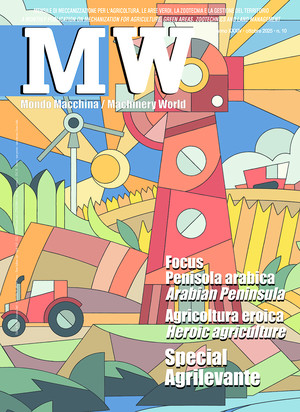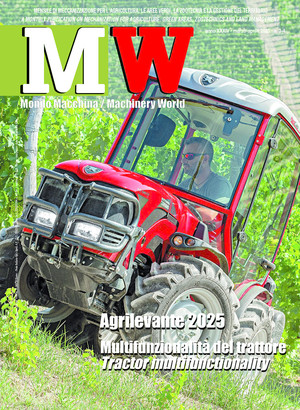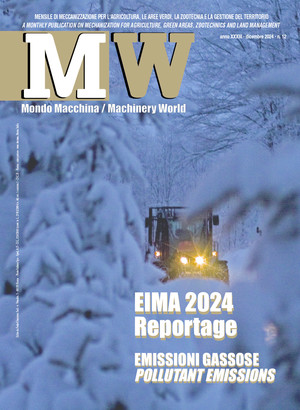CLAAS relaunches its "Jaguar" series
Given that it is one of Claas' strategic vehicles, it is no coincidence that the German brand continues to invest in the Jaguar forage harvester. Four new models – the 1080, 1090, 1100 and 1200 – with power outputs ranging from 850 to 1,110 Hp will begin series production in autumn 2025 and will be fully operational in the fields in 2026. According to the Harsewinkel-based company, these models incorporate several highly innovative solutions capable of defining new, improved benchmarks in the sector. Some of the more important innovations include the increased capacity product flow, the fully hydraulic pre-compression, the new Corn Cracker, the transmission with two independent drives of the variable front implement, the front pick-ups, the high-productivity Orbis header and the improved driver assistance systems.
Let's take a look at them in order.
Pre-compression system and V-Flex knives. According to Claas, the Jaguar 1000 models feature the widest crop feed channel on the market and a new pre-compression system in which four fully hydraulic rollers operate and allow for uniform crop flow regardless of the thickness of the crop layer, ensuring regular feeding of the V-Flex knife drum. The pre-compression rollers can be raised hydraulically for cleaning: with Quick Access the entire pre-compression unit can be rotated up to 80 degrees for maintenance. The V-Flex knife drum has a width of 910 mm, ensuring continuous product flow, even with high product thicknesses, for example when harvesting corn silage. The cutting angle is 10 degrees and the V-Flex features knives fixed with three screws to the drum stars, and automatically aligned. Claas says that it is not necessary to adjust the knives on the counterblade or readjust them after a certain number of working hours.
Multi Crop Cracker XL and pick up. Productivity levels of up to 500 t/hour require effective grain treatment which in the Jaguar 1000 is provided by the Multi Crop Cracker XL, available both in the classic version with a serrated profile with coarse or medium teeth and a speed differetial of 40%, and in the Shredlage version with a speed differential of 50%. The crop accelerator has also been adapted to the increased power of the new series. The hydraulic adjustment range of the accelerator to the back panel is up to 60 mm, allowing for adjustment of the jet stream. Also worth mentioning here is the new exhaust pipe, which can be folded down for road transport.
The 3000, 3800 and the new 4500 pick-ups are equipped with independent variable speed drive for the pick-up reel and the intake auger. The Cemos Auto Header automatically adapts the speeds of the auger and pick-up reel to the cutting length and flow rates during harvesting. The models cover working widths of 3, 3.80 and 4.50 metrers and, instead of chain drives, mechanical power is transmitted via cardan shafts and gearboxes. The cam track system of the 5-row harvester roller is oil lubricated. Furthermore, the scrapers between the tines are made of sturdy plastic and, thanks to the clip system, can be removed individually.
Next-generation Orbis attachments. The new Orbis front attachments come in working widths of 9 and 10.50 m (with 12 and 14 rows) with independent variable drive of the transport discs and vertical feed drums. Product flow rates can be adjusted from the cab based on the cutting length and the feed speeds in automatic harvesting mode. Three sensors detect unevenness in the ground and adjust the pre-selected working height.
The Orbis 10500 uses actively controlled stabilizer wheels to maintain working height regardless of terrain or travel speed. For road transport, the Orbis 9000 is 3 m wide and the Orbis 10500 has a 3.30 m external width. The headers are connected to the multifunction socket for operating the cutting discs and to the second electro-hydraulic socket for independent variable operation of the vertical feed rollers.
Let's take another look inside the engine. Even in the Jaguar 1000, a multi-groove Powerband belt takes power directly from the 24-liter V12 crankshaft of the Man engine and transfers it to the cutter rotor, the crop accelerator and from there to the Corn Cracker. For the transmission, pre-compression and independent drives, a pump transfer gearbox is located at the rear left of the engine, which drives the hydraulic motors. The transmissions have been newly designed for better efficiency. When traveling on the road, only the traction drive is active; the chopping, intake and attachments are decoupled from the main gearbox.
The Jaguar 1000 comes with all-wheel drive and intelligent four-wheel management as standard. Optional features include differential locks on the front axle and, exclusively for forage harvesters, on the rear axle, as well as a tire pressure regulation system for the front and rear axles.
Nutrimeter sensor and smart connection. With its new forage harvester series, Claas is introducing the latest generation of the Nutrimeter sensor, capable of detecting dry matter content in real time. This makes it possible to automatically adjust the length of the chopped material. In addition to dry matter content, the sensor also measures other parameters such as starch, protein and sugar. A new feature is the mobile use of the NIR sensor as Isobus equipment.
A completely new optional feature inside the cab is the joystick for use in the field. The steering joystick has two steering modes and can be customized to various intensity levels. In addition, the armrest has three built-in switches for six independent function designations, such as lowering and raising the exhaust, the horn or the work lights.
The Jaguar series is now fully connected to the Claas Connect system, an intelligent platform that integrates vehicle and farm management. Relevant data (fields, baselines, equipment, vehicles, and manpower) can be recorded, analyzed, optimized, and compared for performance and efficiency to optimize work sessions and business operations. Claas says that real-time yield mapping will also be available on the Cemis 1200 starting in 2026. This will make it possible to view the yield and humidity live on the Cemis display itself in the form of a map during the harvest.








